August 29, 2009
Beware The Fabian Window... Or Not.
How does a 99 year old English stained glass window figure into American politics today? Well, of course... it doesn't.
But that is the contention of a Canadian conservative website, in two articles with the titles Barack Obama's Fabian Window, and Beware Obama's Fabian Window.
I hesitate to link to these articles since they are so much a part of the nonsensical, conspiracy prone, knee-jerk conservatism that is running rampant at the moment, and to point to them seems to give them a credence that they do not merit.
But come on... this is pretty funny. Both funny/strange and funny/haha.
Even without the crazy conspiracy types projecting Barack Obama into the mix, the Fabian Window is still an interesting panel. See for yourself. Personally, the sinister conspiracy alludes me.
The Fabian Window, circa 1910
Designed by George Bernard Shaw
Fabricated by Caroline Townshend
click on the picture to see a larger image, in a separate window -
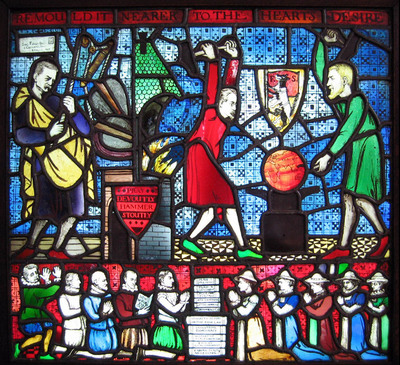
photo by flickrites Ruth and Dave
From April 2006, a BBC news magazine article called, Wit, wisdom and windows, on the unveiling of the Fabian window at the London School of Economics, where it now resides.
This is a listing of the people depicted in the window, from the London School of Economics web page -
The first man, crouching on the left, is HG Wells, shown cocking a snook at the others, after a disagreement with fellow Fabians. He is followed by the actor-manager Charles Charrington, Aylmer Maude (translator of Tolstoy’s War and Peace), G Stirling Taylor (reading a book, New Worlds for Old), and the dentist F Lawson Dodd. The women, from left to right, are Maud Pember Reeves (mother of Amber Reeves, who bore Wells a daughter in 1909), Miss Hankin, the suffragist Miss Mabel Atkinson, Mrs Boyd Dawson, and, at the end, the artist who made the window, Caroline Townshend herself.
The stained glass artist who made it was Caroline Townshend. She is depicted in the window in the lower right corner of the. Here is a blog post about some Sketches by Catherine Townshend, and a nice Flickrset of Caroline Townshend Windows by Flickrite davewebster14
August 23, 2009
Influences - Len Lye
Len Lye never worked in stained glass. Still, I consider his works an important influence on my stained glass work.
As a film animator, Len Lye drew, painted, scratched, and printed directly onto the motion picture film itself. This film is called Trade Tattoo, made in 1937, and it represents his most complex mix of style, image, music and message. It's my favorite of Lye's films.
So how does this influence a stained glass artist? For me, it made me think about working directly with the glass itself and not pre-designing on a piece of paper or in a computer - bashing away at the glass in an improvisational manner without a set idea where it would go. Sometimes it comes together, sometimes not, but I would never have come up with a design like this, or even this, without seeing these Len Lye films first.
Len Lye purists don't tend to mention Trade Tattoo, as the commercial 'message' is more fully integrated into the film. They prefer to show the ones that either just show the message as a throwaway at the end or the later films that are purely abstract.
If you're interested, there are more Len Lye films, plus a peek at his kinetic sculpture, embedded below the fold...
[update August 25, 2009 - just found out there is a big Len Lye Exhibition going on at the Australian Centre for the Moving Image, in Melbourne, though October. Interesting coincidence...]
Colour Box is probably his most famous film, and is always included in screenings of Lye's works. Made in 1935, it was the first film of his using the direct film process that was screened to the public.
Swinging the Lambeth Walk, 1940 -
Usually these early works are shown only because they can be shown as precursors to the real artistic works of Len Lye.
This is Free Radicals, made in 1958, some 25 years after the earlier films. It's a pure, non-message abstract film. Personally I find it a bit too dour for my taste, but it is still a decidedly great abstract work. I especially like the almost 3D quality of the shapes spinning in space.
For all his fame as a pioneer animator, Len Lye is probably best known in his native New Zealand for his kinetic sculptures. There are a few YouTube videos that demonstrate the kinetic sculptures, including some like this, Kinetic Sculptures, with Lye himself talking about the work.
I like this one best though -
The cheekygirl10 Guide to Len Lye -
August 19, 2009
Postmodern Grisaille at Nevers Cathedral
Nice Flickrset by michalska of windows from Nevers Cathedral, designed by Jean-Michel Alberola and fabricated at Ateliers Duchemin. No date given but I would guess early to mid 1990's.
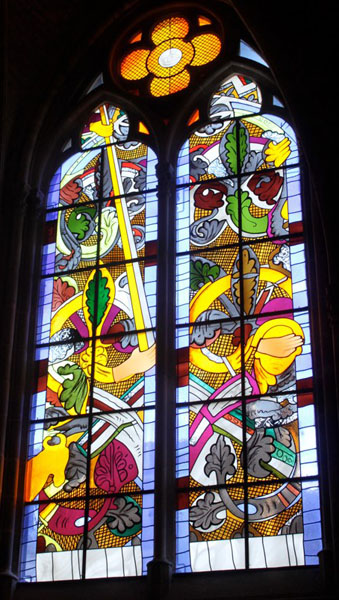
and a closer look
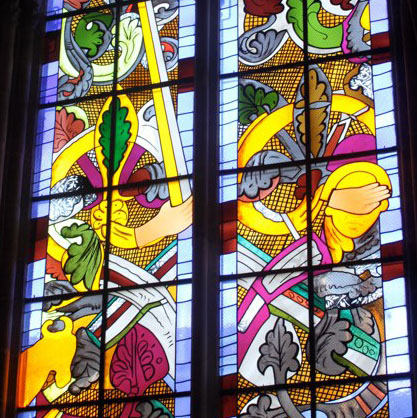
The overall idea is to play around with the idea of the ancient grisaille windows.
To get some context, here are some image of older grisaille windows -
Grisaille Panels
France, Normandy, Rouen, about 1265
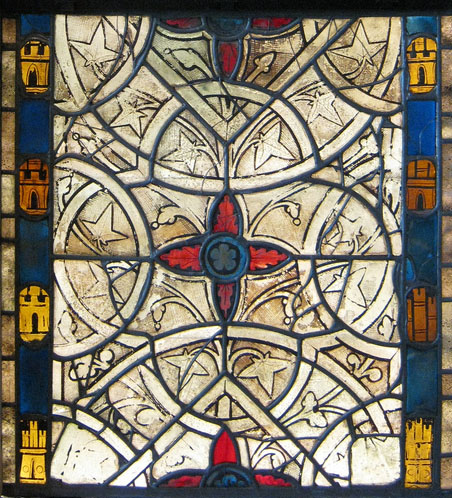
from flickrite peterjr1961
These glass panels may have originally decorated one of the chapels of the Chareau de Bouvreuil, which was built by King Philip Augustus and expanded by his grandson Louis IX.
Grisaille sections of fourteenth-century French stained glass windows, now in the Cloisters, New York City.
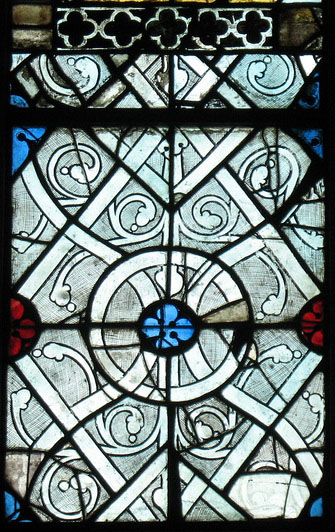
from flickrite loopweaver
A more recent example of grisaille -
'Veritas' from the Virtues window
MacDonald/MacPherson, 1874
Memorial Hall, Harvard University, Cambridge Mass. USA
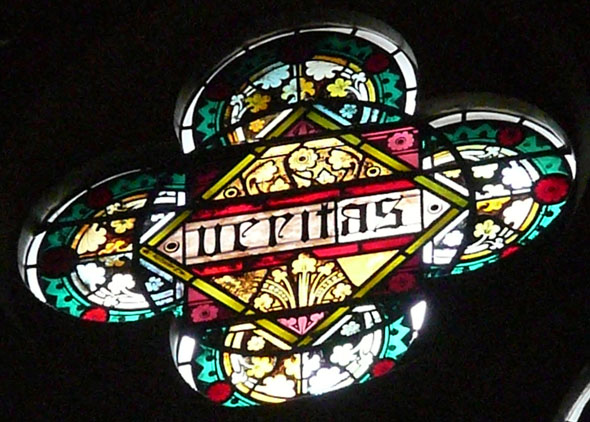
lukethelibrarian
August 13, 2009
Judith Schaechter at Pilchuck
Nice set of images from Judith Schaechter's class at Pilchuck.
by Sarah Tippett
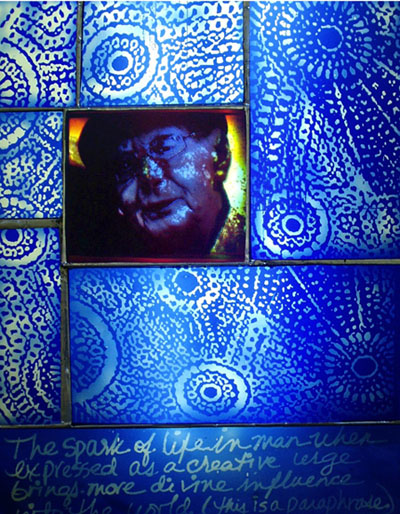
I think I like this one best because I am very much in a blue phase with my work.
August 06, 2009
Dan Maher Talks About Corn and Stained Glass
Dan talks about his "Pig With Corn" panel at the AGG conference in Buffalo, New York, July 2009.
via YouTuber RJJacobson
Dan and I did a talk together at the AGG conference this year on the various screenprinting/photoblast processes we use in our work. We hope to do a full day workshop on these processes at the next AGG conference in Detroit, in July 2010.
Stay tuned...
August 03, 2009
John K. Clark Video 2 - End of the Age of Innocence
Another excellent video with John K. Clark talking about one of his stained glass commissions, End of the Age of Innocence, created for a private residence in North Carolina.
Again, a very nice and simple way of telling the story of a window, as well as giving some technical background as well.
August 01, 2009
Kalman Can Do
There has been a continuing series of wonderful web-based graphic essays by Maira Kalman created for the New York Times, most recently on American subjects like Thomas Jefferson (Time Wastes Too Fast), The Supreme Court (May It Please The Court), Abraham Lincoln (In Love With A. Lincoln), and the American Town Hall Meeting (So Moved). Kalman works in a unique style mixing handwritten text with photos or found images and her uniquely simple, highly personal paintings. Eclectic but coherent, I find these a great mix of graphics/text, all present to serve the content.
This past week came her best essay yet, in my opinion - Can Do, initially about Benjamin Franklin, but eventually becoming more a general essay on invention in America with, hidden inside, that simple but powerful message - Go Invent Something. Good advice in these challenging times.
Interesting that she includes patent pages within the essay. Last April, I started looking at stained glass patents in Google Patents, culminating with my blogpost on steel wheel glass cutters. I'm working on a few more "Google Patent" posts, including ones on Belcher Mosaic patents (and all the wacky variants through the years) and the dueling patents of Tiffany v. LaFarge.
This is one example of a very significant stained glass related patent (albeit with a rather boring looking patent image) -
Joining Glass Mosaics, by Sanford Bray, Boston, 1886
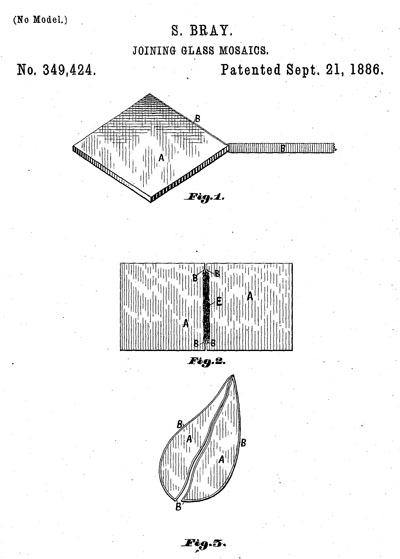
This is the original patent for the copper foil method of construction.
Without this invention, there would be no Tiffany Lamps, and no Judith Schaechter panels, and no... well, about 60% of my own work.
So -
Thank You for your inventiveness, Sanford Bray, whoever you are.